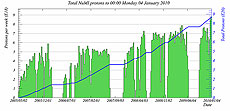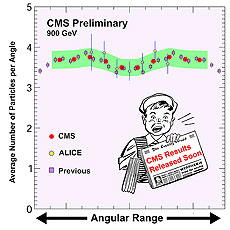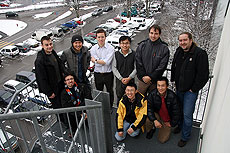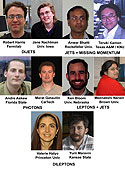|
Have a safe day!
Friday, Jan. 8
3:30 p.m.
DIRECTOR'S COFFEE BREAK - 2nd Flr X-Over
4 p.m.
Joint Experimental-Theoretical Physics Seminar - One West
Speaker: Marat Gataullin, California Institute of Technology
Title: First LHC Collisions with CMS
Monday, Jan. 11
2:30 p.m.
Particle Astrophysics Seminar - One West
Speaker: Hugh Lippincott, Yale University
Title: DEAP/CLEAN: Detecting Dark Matter with
Liquid Argon (and Neon)
3:30 p.m.
DIRECTOR'S COFFEE BREAK - 2nd Flr X-Over
4 p.m.
All Experimenters' Meeting - Curia II
Click here for NALCAL,
a weekly calendar with links to additional information.
Upcoming conferences |
|
For information about H1N1, visit Fermilab's flu information site.
|
|
Friday, Jan. 8
- Breakfast: chorizo burrito
- Old fashioned ham & bean soup
- Philly-style chicken
- Chicken pot pie
- Baked fish over rice
- Roasted veggie & provolone panini
- Assorted sliced pizza
- Baked potatoes
Wilson Hall Cafe menu |
|
Wednesday, Jan. 13
Lunch
- Spicy black bean & sausage calzone
- Confetti corn salad
- Pineapple flan
Thursday, Jan. 14
Dinner
- Closed
Chez Leon menu
Call x3524 to make your reservation.
|
|
|
NuMI shatters old records during holidays
 |
| The plot shows the weekly integrated protons on target from Monday to Sunday since 2005. The last two weeks, displayed at the far right of the plot, show the record-breaking periods. |
Neutrino experimenters at Fermilab got a big gift for the holidays: a record neutrino beam intensity.
During the holidays, the NuMI beamline, which uses protons to create neutrinos, repeatedly surpassed two protons-on-target records: for a single day and for a week.
NuMI smashes protons on a graphite target to break the particles apart. The particles that emerge from these collisions—such as pions and kaons— eventually decay into neutrinos. NuMI provides a high-intensity beam of neutrinos to the MINOS experiment, which studies the particles' behavior, as well as the MINERvA and ArgoNeuT experiments.
The original protons-on-target record for one week (Monday - Sunday) was 78.7 x 1017, set during the week of April 13, 2009. That record was broken twice during the holidays, once during the week of Dec. 21-28 and again during the week of Dec. 28-Jan. 4. The sum for the week of Dec. 21 was 84.6 x 1017 and the sum for the week of Dec. 28 holds the new record at 88 x 1017 protons on target.
The new record for one day with most protons on target is 13.3 x 1017, set on Dec. 26, 2009. Prior to the current running period, which began on Oct. 1, 2009, the protons on target record for a single day was 12.2 x 1017, set on April 14, 2009. Since Oct. 1, that record has been broken 17 times, including on 10 of the 14 days during the two-week holiday period.
Chris White, the co-run coordinator of the MINOS experiment, attributed the milestone to the performance of all involved.
"Having a great day is one thing, but running well for two weeks is something else," White said. "What sets this run apart is the consistent performance of the accelerator complex and the NuMI facility."
-- Rhianna Wisniewski
|
CMS first measurements
 |
| This is just a sample of the many measurements that CMS has made in their studies of charged particles from their recent data taken at a collision energy of 900 GeV. This measurement is in excellent agreement with earlier studies and a similar measurement by ALICE, another LHC experiment. The red points represents the new data and the green band represents the measurement uncertainty. |
When people ask me about the LHC and the time it will take to make measurements, I always caution them that it takes a while to understand the detector and they should guard against unreasonable expectations. We will not find the Higgs boson in the first week of running.
However, while a paradigm-shaking discovery might take a little while, we should remember that the LHC did deliver a million collisions to the four detectors at an energy of 900 GeV, as well as a smaller data sample at 2,360 GeV.
In the last ROM, I showed that we are starting to rediscover familiar particles. This is a necessary first step in understanding our data. However CMS physicists are going much further than that. With this first small data set, we are making publication-quality measurements.
One universal feature of high-energy particle collisions is that many charged particles are made during the interaction. When an experiment first begins colliding beams, the first thing physicists must do is to study these particles to verify that they have the same range of energy and spatial distribution as earlier measurements. In addition, it's important for physicists to verify that the right numbers of charged particles are produced in each collision. Failure to verify could indicate a failure of the equipment or (and this is far less likely) a discovery.
After studying several of these distributions (only one is shown here), the CMS results are in excellent agreement with earlier measurements and these results are likely to be CMS' first publication. The speed at which these results have become available is a testimony to all of the hard work that has gone into designing and building the equipment, the grid computing and analysis software, as well as the enthusiasm and expertise of the analyzers.
They say that the journey of a thousand miles begins with a single step. CMS has taken that step.
-- Don Lincoln
 |
| The CMS group at MIT, working with a team from Budapest, has applied their expertise learned while working on the PHOBOS experiment at the RHIC facility to provide this quick and valuable measurement. From left to right: Ivan Amos Cali, Yetkin Yilmaz, Yongsun Kim, Ed Wenger, Yenjie Lee, and Frank Ma, from MIT; Gabor Veres, Eotvos Lorand University & CERN; Tae Jeong Kim, SungKyunkwan University; and Christof Roland, MIT. Also involved in the analysis, but not pictured: Krisztian Krajczar, Budapest; Constantin Loizides, MIT; Gunther Roland, MIT; Ferenc Sikler, Budapest; and Andre Yoon, MIT. |
 |
The Fermilab LHC Physics Center provides scientists in the U.S. a central place to go to collaborate. Among other things, it has groups of people with expertise in specific types of experimental signatures. These are the leaders of the five event topology groups. |
|
|
|
NOvA contract awarded to Wisconsin plastic company
 |
| Extrutech Plastics produced these 51-foot panels during the R&D phase for the NOvA project. |
Fermilab has awarded a company based in Manitowoc, Wisc., with one of the largest purchase orders related to the NOvA neutrino detector project.
The American Recovery and Reinvestment Act funded the $9.3 million contract with extruding company Extrutech Plastics Inc.
"We're thrilled," said Greg Sheehy, president of Extrutech Plastics."This is my largest purchase order ever."
Extrutech Plastics will extrude about 11 million pounds of sturdy, reflective plastic that scientists need to build the about 23,000 PVC panels that compose the NOvA far detector. A plastic extruder functions somewhat like a spaghetti maker; it heats resin and pushes it through a stainless steel die and then into calibrators that cool and size the panels into the final, uniform shapes.
In order to process the order, Extrutech Plastics will need to increase its staff of 50 by 15-25 new quality-control, process, material-handling and warehouse employees over the next three years, Sheehy said. Extrutech Plastics also will purchase a large extruder and other equipment, such as a water chiller.
The contract will last through 2012. Production will begin in April, and the company is scheduled to begin shipping parts to the University of Minnesota in June. The completed detector, formed in an elongated cube, will reach more than 50 feet tall and weigh about 14,000 tons when filled with liquid scintillator.
"A detector like this has never been built anywhere," said Richard Talaga, who manages the extrusion project at Argonne National Laboratory. "No one has built a structure made of pure plastic of the size we''re building."
Fermilab and Argonne National Laboratory worked with Extrutech Plastics throughout the R&D phase of development for the NOvA detector, said Mike Yeoward of Fermilab's procurement office. "These guys are very solid when it comes to quality control. Additionally, they're very accommodating and easy to work with."
Extrutech Plastics specializes in the manufacturing of plastic wall and ceiling panels for use in wet environments that need daily cleaning, such as car washes, food processing plants, clean rooms, laboratories and agricultural buildings.
"NOvA is a highly technical, precise, custom extrusion job," Sheehy said. "It's a door-opener for us; it could help us to make a name for ourselves in the community of national labs."
-- Kathryn Grim
|
|
Deaths:
John Sickler McIver Jr., who retired from Fermilab in November 2006, passed away Dec. 27, 2009, following a long illness. Services were held Jan. 4 at Bethany Lutheran Church in Chicago, with final interment at the Mount Glenwood Memory Garden South. McIver began working for the CD Networking group in August 1988, and remained in the group for the duration of his employment at the laboratory.
|
Pleasant pheasant visitor
 |
| PPD's Pat Poll submitted a photo of a pheasant hen that has been visiting BEG. The hen perches in a buckthorn tree in an area the buildings' residents call their secret garden. The mate has not yet been seen.
|
|
Big picture: 570-megapixel, intergalactic camera
From Wired, Dec. 21, 2009
You're looking at the heart of one of the biggest digital cameras ever conceived - 74 CCD sensors that will go into an enclosure the size of a Mini Cooper. The 570-megapixel shooter is being built at Fermilab by an international team of particle physicists and astronomers, who think it will help solve one of the great mysteries of the cosmos: What is dark energy?
Of course, we don't really know whether dark energy even exists. What we do know is that the universe has been expanding since the big bang. But rather than slowing down like everything else fighting gravity's pull, this expansion seems to be speeding up. Something must be causing this, and astronomers call that something dark energy. The hope is that scientists can use detailed photos to chart the light from galaxies and supernovas, which will show the growth of the cosmos and at least give them more evidence for the existence and effect of dark energy.
Read more
|
|